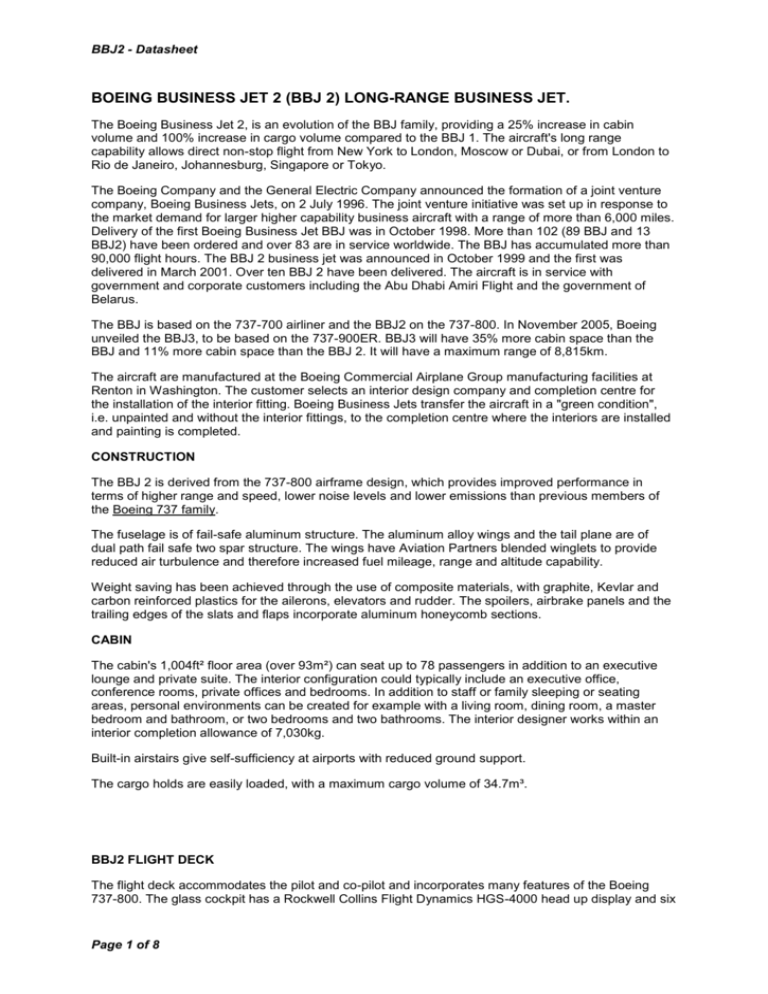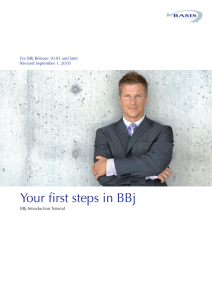Boeing BBJ 2-Datasheet_WORD
advertisement

BBJ2 - Datasheet BOEING BUSINESS JET 2 (BBJ 2) LONG-RANGE BUSINESS JET. The Boeing Business Jet 2, is an evolution of the BBJ family, providing a 25% increase in cabin volume and 100% increase in cargo volume compared to the BBJ 1. The aircraft's long range capability allows direct non-stop flight from New York to London, Moscow or Dubai, or from London to Rio de Janeiro, Johannesburg, Singapore or Tokyo. The Boeing Company and the General Electric Company announced the formation of a joint venture company, Boeing Business Jets, on 2 July 1996. The joint venture initiative was set up in response to the market demand for larger higher capability business aircraft with a range of more than 6,000 miles. Delivery of the first Boeing Business Jet BBJ was in October 1998. More than 102 (89 BBJ and 13 BBJ2) have been ordered and over 83 are in service worldwide. The BBJ has accumulated more than 90,000 flight hours. The BBJ 2 business jet was announced in October 1999 and the first was delivered in March 2001. Over ten BBJ 2 have been delivered. The aircraft is in service with government and corporate customers including the Abu Dhabi Amiri Flight and the government of Belarus. The BBJ is based on the 737-700 airliner and the BBJ2 on the 737-800. In November 2005, Boeing unveiled the BBJ3, to be based on the 737-900ER. BBJ3 will have 35% more cabin space than the BBJ and 11% more cabin space than the BBJ 2. It will have a maximum range of 8,815km. The aircraft are manufactured at the Boeing Commercial Airplane Group manufacturing facilities at Renton in Washington. The customer selects an interior design company and completion centre for the installation of the interior fitting. Boeing Business Jets transfer the aircraft in a "green condition", i.e. unpainted and without the interior fittings, to the completion centre where the interiors are installed and painting is completed. CONSTRUCTION The BBJ 2 is derived from the 737-800 airframe design, which provides improved performance in terms of higher range and speed, lower noise levels and lower emissions than previous members of the Boeing 737 family. The fuselage is of fail-safe aluminum structure. The aluminum alloy wings and the tail plane are of dual path fail safe two spar structure. The wings have Aviation Partners blended winglets to provide reduced air turbulence and therefore increased fuel mileage, range and altitude capability. Weight saving has been achieved through the use of composite materials, with graphite, Kevlar and carbon reinforced plastics for the ailerons, elevators and rudder. The spoilers, airbrake panels and the trailing edges of the slats and flaps incorporate aluminum honeycomb sections. CABIN The cabin's 1,004ft² floor area (over 93m²) can seat up to 78 passengers in addition to an executive lounge and private suite. The interior configuration could typically include an executive office, conference rooms, private offices and bedrooms. In addition to staff or family sleeping or seating areas, personal environments can be created for example with a living room, dining room, a master bedroom and bathroom, or two bedrooms and two bathrooms. The interior designer works within an interior completion allowance of 7,030kg. Built-in airstairs give self-sufficiency at airports with reduced ground support. The cargo holds are easily loaded, with a maximum cargo volume of 34.7m³. BBJ2 FLIGHT DECK The flight deck accommodates the pilot and co-pilot and incorporates many features of the Boeing 737-800. The glass cockpit has a Rockwell Collins Flight Dynamics HGS-4000 head up display and six Page 1 of 8 BBJ2 - Datasheet Honeywell flat-panel liquid crystal flight displays. The HGS-4000 has improved low visibility takeoff guidance, runway deceleration cueing and advanced display features. Smiths Industries developed and supplied the dual flight management computers. The communications systems include Rockwell Collins triple VHF and dual HF communications and a Coltech selective calling system (SelCal). The Rockwell Collins Series 90 avionics system is integrated with a dual automatic direction finding (ADF), TCAS II traffic alert and collision avoidance system and a predictive wind-shear unit. The navigation suite includes dual Rockwell Collins navigation multimode receivers, incorporating a global positioning system (GPS), instrument landing system (ILS) and a VHF omni-directional radio range navigation aid with data from the distance measuring equipment (VOR/DME). The aircraft is equipped with a Honeywell (formerly AlliedSignal) enhanced ground proximity warning system (EGPWS) and an airborne navigation data recorder (ANDR), digital flight data acquisition unit (DAFU) and a quick access recorder supplied by Teledyne. The aircraft's 120min cockpit voice recorder (CVR) and the flight data recorder (FDR) were supplied by L-3 Communications. ENGINES The aircraft has two CFM56-7B27 turbofan engines developed by CFM International, a company jointly formed by General Electric of the USA and Snecma of France. The engines are rated at 27,300lb st thrust. The wing tanks hold 26,025l of fuel. Three to seven auxiliary tanks by PATS, Inc. based in Georgetown, Delaware, provide additional fuel to bring the total maximum fuel capacity to 39,531l. With maximum fuel and a lower baggage hold cargo volume of 800ft³ the range is 5,500 nautical miles. The BBJ 2 is capable of 180mins extended range, twin engine operations (ETOPS) providing access to faster, more direct and shorter routes, for example, over Arctic or Himalayan areas. LANDING GEAR The aircraft has hydraulically operated retractable landing gear in a tricycle configuration. The twin nose wheels retracts forward and the main units retract inwards. The main landing gear wells have no doors but instead the wheels form the wheel well seals that are visible on the underside of the fuselage towards the trailing edge of the wing. The landing gear is equipped with oleo-pneumatic shock absorbers supplied by Boeing and either Honeywell or Goodrich heavy duty wheel brakes. OFFICIAL BOEING SPECIFICATIONS – BOEING BUSINESS JET 2 (BBJ 2) LONG-RANGE BUSINESS JET DIMENSIONS Length Wingspan Tail height Page 2 of 8 39.6 m 35.8 m 12.5 m BBJ2 - Datasheet Fuselage diameter CABIN DIMENSIONS Length Height Width Floor area Interior completion weight allowance Seating WEIGHTS Maximum taxi weight Maximum take-off weight Maximum landing weight Maximum zero fuel weight Typical operating empty weight ENGINES CFMI engines Aircraft fuel capacity PERFORMANCE Maximum cruise speed Initial cruise altitude Maximum cruise altitude Range, 8 passengers Range, 25 passengers Range, 50 passengers Take-off distance, 10,620 km range Take-off distance, 9,260 km range Take-off distance, 7,410 km range Landing distance 3.73 m 29.97 m 2.16 m 3.53 m 93.27 sq m 7,030 kg 78 passengers 79,240 kg 79,015 kg 66,360 kg 62,730 kg 45,730 kg 2 x CFM 56-7 39,525 liters Mach 0.82 (550 mph) 37,750 ft 41,000 ft 10,620 km 10,120 km 9,140 km 2,135 m 1,870 m 1,620 m 834 m GENERAL INDUSTRY SPECIFICATIONS – BOEING BUSINESS JET 2 (BBJ 2) LONG-RANGE BUSINESS JET Boeing BBJ 2* Wing span: Wing area: Winglet height: Engines: Weight: Max. take off weight: Max. landing weight: With 0 auxiliary fuel tanks: Page 3 of 8 35,79 m. 125 m². 2,44 m. - two CFM International CFM56-7B each rated 117.4 kN. - max. zero-fuel weight: 62.730 Kg. 79.015 Kg. 66.360 Kg. - empty: 43.875 Kg. BBJ2 - Datasheet With 1 auxiliary fuel tanks: With 2 auxiliary fuel tanks: With 3 auxiliary fuel tanks: With 4 auxiliary fuel tanks: With 5 auxiliary fuel tanks: With 6 auxiliary fuel tanks: With 7 auxiliary fuel tanks: Range: - max. payload: 18.859 Kg. - cargo volume lower deck: 43,8 m³. - fuel: 26.025 liters. - empty: 44.167 Kg. - max. payload: 18.570 Kg. - cargo volume lower deck: 40,3 m³. - fuel: 27.992 liters. - empty: 44.371 Kg. - max. payload: 18.366 Kg. - cargo volume lower deck: 37,7 m³. - fuel: 29.655 liters. - empty: 44.608 Kg. - max. payload: 18.130 Kg. - cargo volume lower deck: 34,7 m³. - fuel: 31.645 liters. - empty: 44.780 Kg. - max. payload: 17.960 Kg. - cargo volume lower deck: 31,6 m³. - fuel: 33.609 liters. - empty: 45.084 Kg. - max. payload: 17.563 Kg. - cargo volume lower deck: 29,2 m³. - fuel: 35.578 liters. - empty: 45.262 Kg. - max. payload: 17.475 Kg. - cargo volume lower deck: 26,1 m³. - fuel: 37.538 liters. - empty: 45.501 Kg. - max. payload: 17.236 Kg. - cargo volume lower deck: 23,1 m³. - fuel: 39.530 liters. - 8 passengers: 10.620 km. - 25 passengers: 10.120 km. - 50 passengers: 9.140 km. * Generally similar to the Boeing 737-800 except in the above stated particulars. PICTURE GALLERY BOEING BUSINESS JET 2 (BBJ 2) LONG-RANGE BUSINESS JET Page 4 of 8 BBJ2 - Datasheet BBJ and BBJ2 Comparison of size BBJ2 – inflight view BOEING BUSINESS JET 2 (BBJ 2) LONG-RANGE BUSINESS JET Page 5 of 8 BBJ2 - Datasheet Cut-away view Example Full “Glass” cockpit configuration BOEING BUSINESS JET 2 (BBJ 2) LONG-RANGE BUSINESS JET Page 6 of 8 BBJ2 - Datasheet Example Dining room configuration Example BBJ2 Lounge area configuration BOEING BUSINESS JET 2 (BBJ 2) LONG-RANGE BUSINESS JET Page 7 of 8 BBJ2 - Datasheet Page 8 of 8







